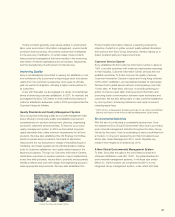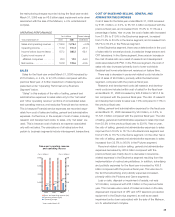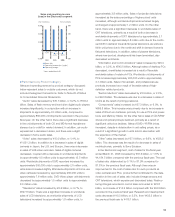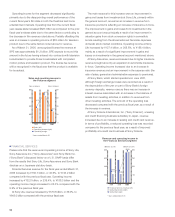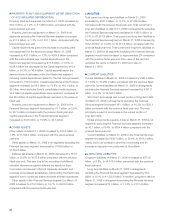Sony 2006 Annual Report Download - page 56
Download and view the complete annual report
Please find page 56 of the 2006 Sony annual report below. You can navigate through the pages in the report by either clicking on the pages listed below, or by using the keyword search tool below to find specific information within the annual report.54
Selling, general and administrative expenses decreased by
¥27.2 billion, or 2.8%, to ¥933.0 billion compared with the
previous fiscal year. The primary reason for this decrease was
the recording of a ¥64.5 billion net gain resulting from the
transfer to the Japanese Government of the substitutional
portion of Sony’s Employee Pension Fund. Of the restructuring
charges recorded in the Electronics segment, the amount
recorded in selling, general and administrative expenses
decreased by ¥4.1 billion from ¥53.6 billion in the previous fiscal
year to ¥49.5 billion. Of the restructuring charges recorded in
selling, general and administrative expenses, the amount
recorded for headcount reductions, including reductions through
the early retirement program, was ¥45.1 billion, a decrease of
¥5.8 billion compared with the previous fiscal year. On the other
hand, royalty expenses decreased ¥17.2 billion. The ratio of
selling, general and administrative expenses to sales decreased
0.9 percentage point from the 19.0% recorded in the previous
fiscal year, to 18.1%.
Loss on sale, disposal or impairment of assets, net increased
¥40.0 billion to ¥63.9 billion compared with the previous fiscal
year. This amount includes ¥52.5 billion in restructuring charges,
which includes ¥25.5 billion of restructuring charges related to
CRT and CRT television manufacturing facilities in the U.S. The
amount of restructuring charges included in loss on sale, disposal
or impairment, net in the previous fiscal year was ¥19.2 billion.
The amount of operating loss recorded in the Electronics
segment for the fiscal year ended March 31, 2006 decreased
as a result of the net gain resulting from the transfer to the
Japanese Government of the substitutional portion of Sony’s
Employee Pension Fund, despite the recording of increased
restructuring charges. Regarding profit performance by product,
excluding restructuring charges and the impact of the net gain
resulting from the transfer to the Japanese Government of the
substitutional portion of Sony’s Employee Pension Fund,
operating losses recorded by CRT televisions and LCD televisions
increased, in addition to a decrease in operating income recorded
by image sensors. On the other hand, the amount of operating
loss recorded by DVD recorders (including PSX™) decreased. In
addition, there was an increase in operating income for video
cameras and PCs.
In August 2006, Dell Inc. (“Dell”) and Apple Computer Inc.
(“Apple”), each announced voluntary recalls of lithium-ion battery
packs used in certain notebook computers sold by these two
companies. The recalled packs contain battery cells originally
manufactured by Sony. Sony supports these recalls by our
customers Dell and Apple.
As of August 31, 2006, Sony anticipates no further recalls of
battery packs using these particular battery cells.
The recall arises because, on rare occasions, microscopic
metal particles in the recalled battery cells may come into
contact with other parts of the battery cell, leading to a short
circuit within the cell. Typically, a battery pack will simply power
off when a cell short circuit occurs. However, under certain rare
conditions, an internal short circuit may lead to cell overheating
and potentially flames. The potential for this to occur can be
affected by variations in the system configurations found in
different notebook computers. Sony has introduced a number of
additional safeguards into its battery manufacturing process to
address this condition and to provide a greater level of safety
and security.
As of August 31, 2006, Sony estimates that the overall cost to
Sony in supporting the recall programs of Apple and Dell will
amount to between ¥20 billion and ¥30 billion. This overall cost is
an estimate based on the costs of replacement battery packs and
any other related costs to be incurred by Sony.
● Manufacturing by Geographic Area
Slightly more than 50% of the Electronics segment’s total annual
production during the fiscal year ended March 31, 2006 took
place in Japan, including the production of digital cameras,
video cameras, flat panel televisions, PCs, semiconductors and
components such as batteries and Memory Stick. Approximately
65% of the annual production in Japan was destined for other
regions. China accounted for slightly more than 10% of total
annual production, approximately 70% of which was destined
for other regions. Asia, excluding Japan and China, accounted
for slightly more than 10% of total annual production, with
approximately 60% destined for Japan, the U.S. and Europe.
The Americas and Europe together accounted for the remaining
slightly less than 25% of total annual production, most of which
was destined for local distribution and sale.
●Comparison of Results on a Local Currency Basis and
Results on a Yen Basis
In the Electronics segment, operating results benefited from the
positive effect of the depreciation of the yen against the U.S.
dollar and the Euro. Sales for the fiscal year ended March 31,
2006 increased, on a yen basis, by 1.7%, but decreased on a
local currency basis by approximately 3%. In terms of operating
performance, there was a decrease in the amount of operating
loss compared to the previous fiscal year, but if calculated on a
local currency basis, this operating loss was larger when
compared to the actual results on a yen basis.
Sales to outside customers by geographic area on a yen basis
decreased in Japan by 12%, in the U.S. by 1% and in Europe by
4%. However, sales increased in Other Areas by 11%. Sales on
a local currency basis for regions outside Japan decreased in the
U.S. and Europe by 7%, but increased by 2% in Other Areas.



